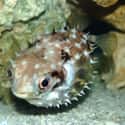-
(#9) Dolphins Commonly Carry STDs
Like many animals, dolphins usually carry sexually transmitted diseases like genital warts. When you think about it, it makes sense considering that dolphins don't know how to use protection like humans do. They don't think about the consequences of intercourse, which leads to STDs being passed frequently in the animal kingdom.
However, research suggests that some STIs in humans originally came from animals. That's yet another reason to keep your distance from wild dolphins.
"Two or three of the major STIs [in humans] have come from animals. We know, for example, that gonorrhea came from cattle to humans. Syphilis also came to humans from cattle or sheep many centuries ago, possibly sexually," said Alonso Aguire, a vet and president for conservation medicine at the Wildlife Trust.
-
(#7) Dolphins Use Toxic Pufferfish To Get 'High'
If you thought humans were the only creatures to abuse dangerous substances, think again. Animals like horses, elephants, and monkeys have all been reported to be drawn to toxic substances the way that humans are interested in alcohol. As it turns out, dolphins are guilty of this, too. Of course, animals don't process ideas like "drug abuse" the same way we do, but it seems to be a repeated behavior.
Dolphins have been seen playing with toxic pufferfish, passing them back and forth like a beach ball. Pufferfish release a foul, dangerous substance when threatened, so the dolphins ingest it as they play with the pufferfish. Large amounts of this toxin can be life-threatening, but small amounts only put creatures in a "trance-like state."
According to zoologist Rob Pilley, dolphins in a BBC documentary were seen mesmerized at their own reflection on the water's surface after biting a pufferfish.
-
(#4) Bottlenose Dolphins Attack Porpoises For Fun
Dolphins regularly eat fish, which is something most people are comfortable with. Yet, it's a bit more unsettling when they hunt animals closer to their own size. Researchers have witnessed bottlenose dolphins throwing and "attacking" porpoises. Dolphins don't eat porpoises, but they still bite them, toss them, ram into them, and sometimes even kill them.
Scientists have observed porpoise carcasses washing up on shore with scars that look like dolphin teeth marks. It's difficult to know the exact reason for these behaviors. These attacks could be related to territorial behaviors, a sense of competition, or just a fun activity. Either way, their body language displays that it's likely something dolphins enjoy doing, despite how much it scares humans.
-
(#2) Wild Dolphins Have Shown Signs Of Sexual Aggression Towards Humans
Do dolphins sexually attack humans? Many videos, including one posted to YouTube by Michael Maes, have shown that swimming and diving with dolphins might not be as innocent as you'd think. Divers have seen dolphins climb on top of humans, and many even appear aroused. While these behaviors are disturbing to us, they aren't classified as "rape." Since dolphins don't understand the concept of consent like we do, their intent may not be malicious, and we can't assume why they're doing it. Yet, it's a surprisingly common behavior.
In fact, authorities have warned swimmers of sexually aggressive dolphins in certain bodies of water, including Weymouth Harbor, England. While it's unlikely that these sea creatures are trying to have full-on intercourse with humans, these events can be horrific and could lead to injury or drowning.
-
(#1) Groups Of Male Dolphins 'Aggressively Herd' Individual Females
"Aggressive herding" is a scientific name used to describe the uncomfortable way male dolphins find their partners. When mating with females, male dolphins normally form alliances of two or three. Yet, female dolphins can be pursued by up to 13 males during a single season. While male dolphins can be attracted to a female at any given time, they are most likely to aggressively herd if the female has a calf between 2 and 2.5 years old, or if she lost a calf between one and two weeks ago.
During this mating routine, the males choose a female and relentlessly mate with her for weeks at a time. If she tries to escape, she is chased. The males will frequently beat her with their flippers to maintain dominance.
While this sounds like a form of rape to humans, it is often spoken of in scientific literature as a normal mating ritual. It is, however, an unquestionably violent mating habit and certainly goes against the "friendly dolphin" stereotypes we see in the media.
-
(#3) Dolphins Kill Other Newborn Dolphins
"Infanticide" is the term used when animals kill helpless newborns from their own species. It most commonly happens with animals like lions and monkeys, but dolphins are capable of it, too. In 2013, scientists observed a bottlenose dolphin give birth in the wild. What should've been a beautiful moment quickly took a dark turn.
Only two minutes after the calf was born, two males tried to drown the newborn. The mother kept trying to push the calf back to the shore, but male dolphins continued to push it down. While the researchers were too far away to spot all the details, they suspect that the males had been waiting around before the female gave birth.
These actions are rare in animals like dolphins, whales, and porpoises. Other cases have been reported though, including one where males threw the calf into the air. Yet, if these infanticides occur underwater, they could be harder to spot. Scientists believe that it happens more than we think, and it might be a way for the males to make females ready to breed again sooner.
New Random Displays Display All By Ranking
About This Tool
Our data comes from Ranker, If you want to participate in the ranking of items displayed on this page, please click here.






